Rat snakes make great captives. The red rat snake, also known as the corn snake is probably the most popular snake kept as a pet.
To hobbyists interested in our country’s native snakes, the rat snakes are among the most familiar, especially to any herpers who grew up prior to the importation of exotic boas and pythons became commonplace in the pet trade. North American rat snakes are large, often colorful and conspicuous, and when first encountered in the field, they will often put on a show of defense that demands attention and is remembered.
When I first encountered them in the early 1970s, rat snakes were all members of the genus Elaphe, but that genus has been reassigned to many of the European and Asian rat snakes. The science of taxonomy is in a constant state of flux as new, supposedly better science leaves us more accurately informed of the relationships between closely related types of snakes.
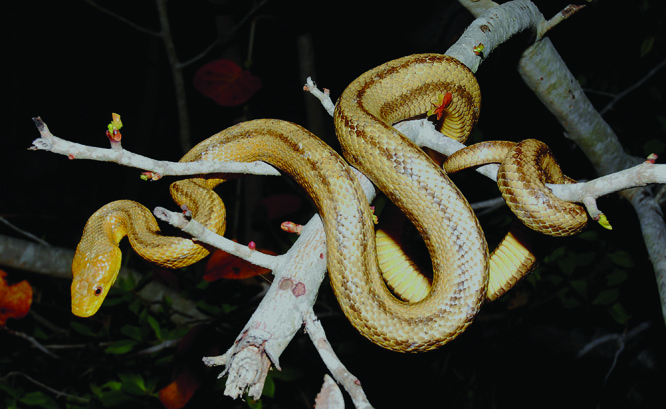
bill love
Rat snakes come in a variety of colors in the wild.
It’s confusing as each new field guide changes the Latin names, leading me to increasingly appreciate how much more stable common names are today for the average person. In recognition of this, in this article, I’ve decided to, for the most part, use the common names that have been used to describe the North American rat snakes for decades. I’m not a taxonomist, so it’s not for me to judge definitively which taxonomy is correct. Even the taxonomists whose job it is to sort this all out don’t agree 100 percent, so I’ll stick with the labels I’ve known all my life for the purposes of this article and the photo captions. I believe most readers will find these names familiar enough to understand which races are being discussed.
It should be noted that many people are now learning that most snakes formerly assigned to the genus Elaphe are now considered to be in the genus Pantherophis. For the latest data on all the North American rat snakes, including their scientific names, refer to the Peterson Field Guide to Reptiles and Amphibians (2016) by Robert Powell, Roger Conant and Joseph T. Collins.
The rat snakes haven’t changed just because some of their names have. They’re all powerful colubrid snakes that subdue their live reptile food of mostly birds and small mammals, by constriction. They range in length from about 8 feet at the top end of the scale for those in the eastern U.S., to more slender, petite forms west of the Mississippi. The majority are at home on the ground as in trees or crevices within rocky terrain in dry habitats. All lay eggs.
Pet Rat Snakes, Briefly
Most U.S. rat snakes make hardy captives, and one type — the corn snake — is among the most popular pet snake species worldwide. If you want to catch your own snakes to keep, be sure you know your local laws regarding the collection of wild snakes. That said, captive-bred snakes are always preferred.
Enclosure Essentials For Rat Snakes
- Up to 20 gallon enclosure or reptile terrarium
- Aspen Bedding or Orchid Bark
- Water Bowl
- Cave or Hide
- Branches, reptile accessories
- Heat Mat
- Snake Lighting (Optional)
Enclosure sizes for pet rat snakes vary by species. They can range from a 10-gallon aquarium (with a screen top) for juveniles of all types up to a 20-gallon aquarium size (12 by 30 inches) for larger rat snakes, such as yellow and black rats. This latter size should be considered minimal; bigger is better.
Essential housing that applies to all rat snakes includes a snake substrate such as aspen bedding or orchid bark, a water bowl that is heavy enough to prevent being tipped over by the snake, and a hiding place, such as a commercially available cave or hide, into which the snake can fit entirely. Something like the Zoo Med Habba Hut will work. These can be found online or in-store. A sturdy branch upon which the snake can climb for exercise would be a nice additional touch.
Rat snakes breed readily in captivity, and their eggs are, for the most part, easy to hatch. Prioritizing reptile health and wellness should give you successful breeding seasons. Every type pictured in this article has been reproduced in captivity multiple times. They grow to maturity within two or three years and generally mate in the spring, after a winter cooling period of several months.
Rodents of appropriate size are appropriate prey items for all rat snakes. Some types, such as young corn snakes and yellow rats, are known to also accept, and sometimes prefer, frogs or lizards as hatchlings.
A word of caution for potential keepers: Just because a snake is captive bred, that doesn’t mean it is tame. Rat snakes that are more than 4 feet long can deliver a strong defensive bite. Most calm down, though, once they exceed 4 feet, especially with gentle handling that will help them to cease aggressive tendencies.
Black Rat Snake
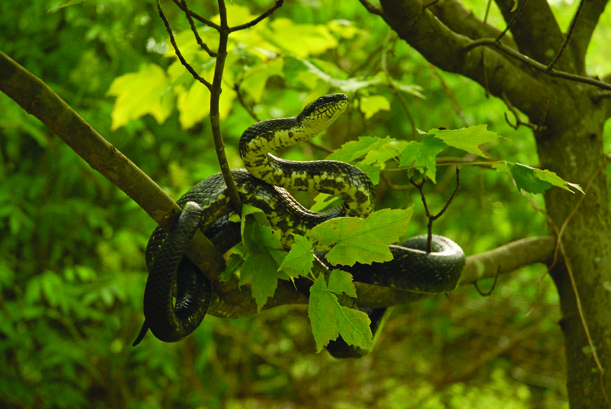
bill love
Black rat snake.
Starting in the northeastern U.S. and proceeding westward, the resident species most familiar to people in that more densely populated part of the country is the black rat snake (originally described as Elaphe obsoleta obsoleta), an essentially solid black snake capable of reaching an impressive 8 feet in total length. Most individuals also have tinges of white and sometimes red or orange. Hatchlings are strongly blotched, but they fade with age.
“Pilot black snake” is another common name due to the belief that black rat snakes lead timber rattlesnakes and copperheads to winter hibernacula that they often share with those vipers.
Gray Rat Snake
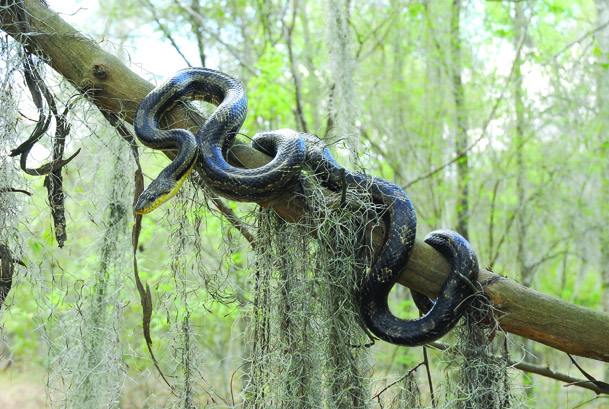
bill love
Gray rat snake.
Moving southward into the southeastern and midwestern U.S., black rat snakes “blend” gradually into a form, popularly called the gray rat snake in field guides, that retains dorsal blotches into adulthood and that is less black overall. The ground color changes to a muted gray to brown.
Local people call the gray rat snake “chicken snake” due to its tendency to enter chicken coops to prey on young birds and eggs.
Gray rats grow just as large as their northern cousins, and like them, are excellent climbers that ascend trees and man-made structures for food and shelter. Adults are capable of swallowing a half-grown chicken or full-grown squirrel.
Yellow Rat Snake
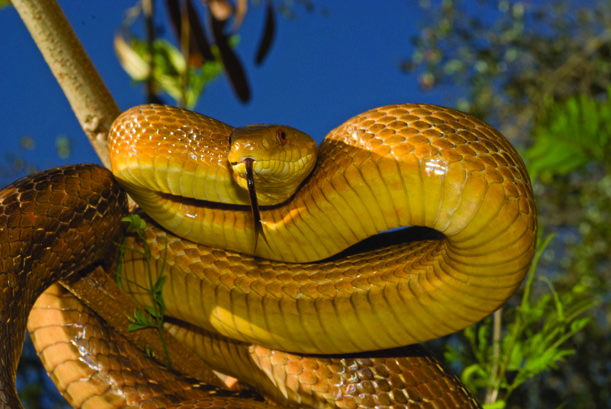
bill love
Yellow rat snake.
About midway down the Florida peninsula, strongly blotched gray rats give way to this snake with moderate to bright yellow coloration and four dark stripes running down their length. The further south, the prettier yellow rat snakes become.
These beauties are agile climbers, easily making their way into the roofs of barns or crowns of palm trees to hunt birds and rodents.
Texas Rat Snake
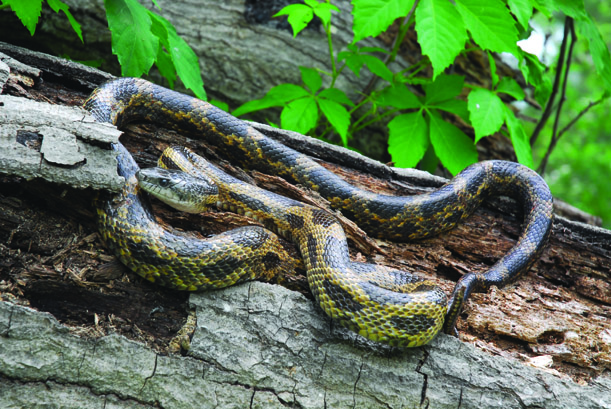
bill love
Texas rat snake.
The gray rat snake eventually “tans out” into warmer tones west of the Mississippi River. While snakes in that area possess all the characteristics of their eastern counterparts, the Texas rat snake has long had a reputation among keepers as being unusually belligerent. This race never gained a dedicated following by herpetoculturists until the pure white leucistic race entered the hobby and garnered attention.
Baird’s Rat Snake
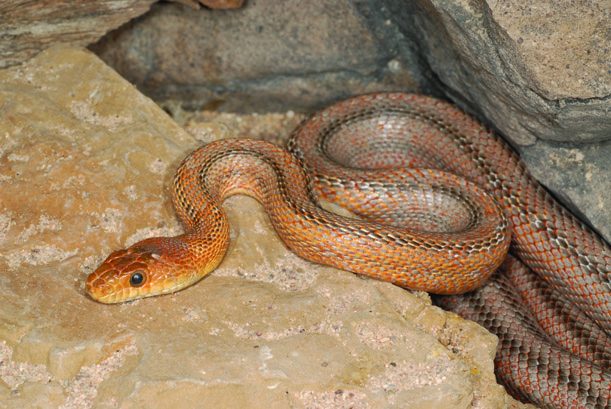
bill love
Baird’s rat snake.
About midway across Texas, heading westward, another rat snake appears. The Baird’s rat snake, with an orange ground color and stripes, resembles the Everglades rat snake. It averages 3½ to 4 feet in length and prefers the more moist, forested canyons and ravines within its dryer
habitat.
Trans-Pecos Rat Snake
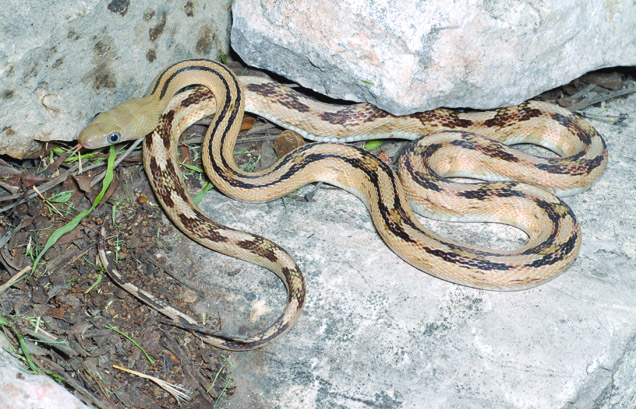
bill love
Trans-Pecos rat snake.
A true desert rat, the Trans-Pecos rat snake reaches more than 6 feet in length and is at home in the dry bleakness of west Texas. It spends most of the heat of the day underground or in rock crevices. Its big, black eyes are an immediate clue to its nocturnal activity mode, and rodents and bats are favorite prey items.
The Trans-Pecos rat snake ranges from the middle of Texas west to south-central New Mexico. Currently classified as Bogertophis suboccularis, its commonly referred to as the “suboc” in the pet trade.
Everglades Rat Snake
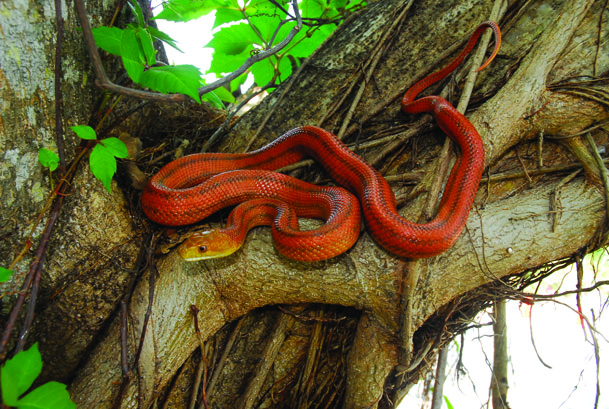
bill love
Everglades rat snake.
Found deep in the Florida Everglades, the Everglades rat snake exhibits a rich, red-orange ground coloration. Many have partially red tongues, too, as opposed to the normal black tongue of a yellow rat.
Originally designated as a separate subspecies, Elaphe obsoleta rossalleni, hobbyists are keeping this race of rat snake alive due to their captive-breeding attempts to intensify the orange ground color. The subspecific name rossalleni has been disregarded by most taxonomists.
Green Rat Snake
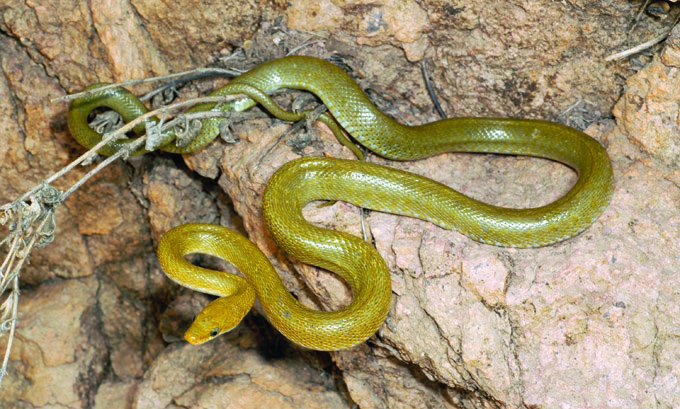
bill love
Green rat snake.
The green rat snake is the northernmost representative of Senticolis triaspis intermedia, a rat snake that’s primarily from Mexico and Central America. In the U.S., it occurs only in certain mountains of extreme southern Arizona, where it emerges from crevices during the late afternoon to hunt.
Baja Rat Snake
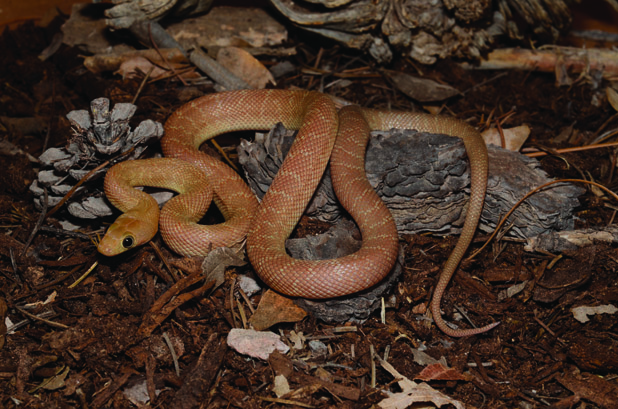
bill love
Baja rat snake.
Primarily a Mexican species of the Baja California peninsula, a few specimens of Baja rat snake are reported to occur in California, just across the border. Adults are a unicolor tan and can reach well over 4 feet in length. They are adapted to living in xeric environments and are very nocturnal in habit.
Fox Snakes
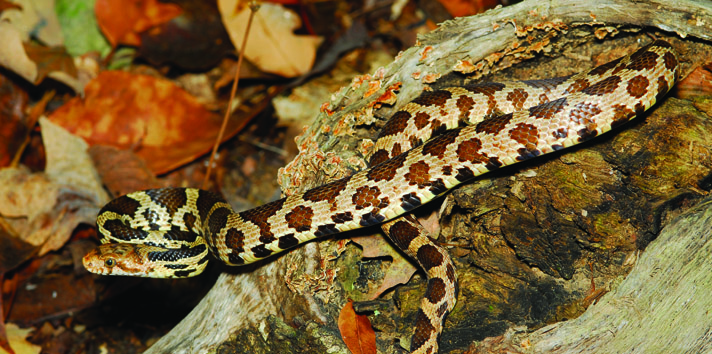
bill love
Eastern fox snake.
The two races of fox snakes are the common rat snakes of the Great Lakes Region of the U.S. They are mainly terrestrial and best known as inhabitants of marshy terrain.
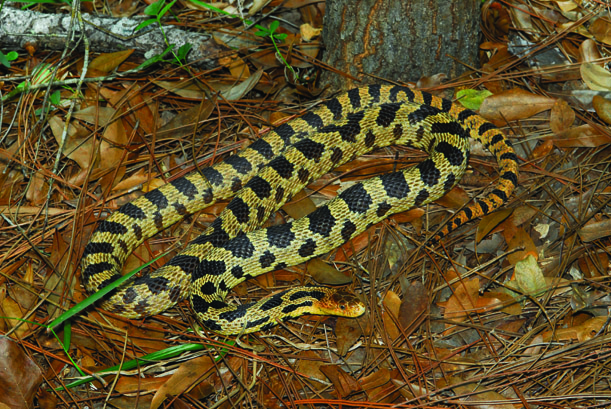
bill love
Western fox snake.
Two variations exist: the eastern fox snake (Pantherophis vulpinus) and the more widespread western fox snake (P. ramspotti). They occupy similar niches to corn snakes further south.
Red Rat (CORN) Snake
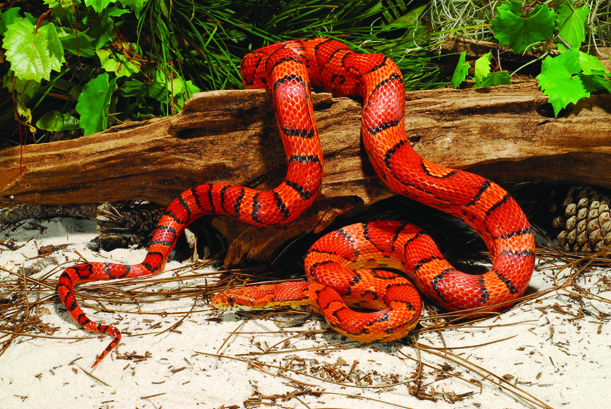
bill love
The red rat snake is also known as the corn snake.
The red rat snake, also commonly known as the corn snake, is possibly the most popular pet snake in America due to its gorgeous colors and gentle disposition.
Corn snakes occur from southern New Jersey down through Florida and westward to, approximately, the Mississippi River. It is a habitat generalist that adapts to habitats disturbed by man, from the edges of cities to agricultural regions where rodents are often abundant.
Many people consider the specimens from coastal South Carolina to be the most colorful, and the moniker “Okeetee corn” that is used in describing them is based on reptile writer Carl Kauffeld’s love and of hunting them on the private grounds of the Okeetee Hunt Club.
Corn snakes typically grow to 4 to 5 feet in length, and occasionally longer. They are active night and day, but especially at dusk.
West of the Mississippi River, corn snakes lose their brilliance, and various races have been described over the decades as Great Plains rats and Emory’s rats under a handful of species and subspecific names such as emoryi, meahllmorum, slowinskii and intermontana.
Bill Love photographs herps in nature, writes and lectures. He assists his wife, Kathy, with her business, CornUtopia, and via his company, Blue Chameleon Ventures, lectures to herp groups and photographs private collections.


